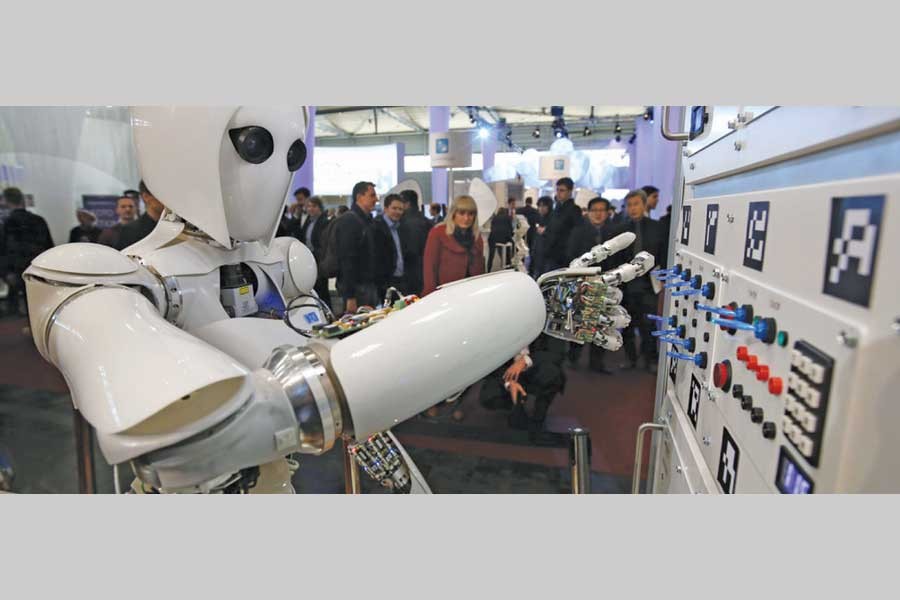Over the last several years, there has been a lot of discussion about a new state of industrial revolution, its consequences, and finding ways to leverage it. This state of industrial progression known as Industry 4.0 or Fourth Industrial Revolution (FIR) is driven by a set of technologies. One of the major characteristics of this revolution is that industrial production machinery and also products are being fused with cognitive capability. As a result, there has been widespread speculation on job loss in developing countries. Thus the obvious question: how far developing countries like Bangladesh are ready to cope with the consequences of FIR and also to leverage it. Here are a few areas that deserve attention.
FIR AND JOB LOSS: Job loss due to technology progression is not a new phenomenon. One of the primary purposes of technology development and innovation is to transfer roles of humans to machines in order to get the job done better at less cost. Therefore, job loss is an integral phenomenon of technology-led progression. Like in the past industrial revolutions, there have been many projections of likely job loss due to FIR.
In the 3rd and 2nd industrial revolutions, technology was focusing on dividing jobs into pieces and reducing the complexity of execution-thereby opening the opportunity of participation of low skilled workforce in the industrial economy. At the cost of a few high skilled professionals' jobs, a far larger number of jobs were created for less skilled people. Although labour content in production was decreasing, the demand for consumption was growing at a faster rate, resulting in a growing requirement for labour. Moreover, due to the lack of cognitive capability of machinery, human workforce was indispensable for productive activities.
FIR MAKES TECHNOLOGY IMPORT-DRIVEN STRATEGY INEFFECTIVE: So far, developing countries are pursuing the strategy of importing production technology from advanced countries and adding labour and raw materials in producing industrial outputs. Low-cost labour has been the comparative advantage for many developing courtiers to benefit from the industrial economy. FIR has been opening a greater possibility of artificially intelligent production machinery innovation, thereby encouraging the adoption of labour-saving production technology. To remain competitive in this globally connected economy, whether for the purpose of import substitution or export, firms in developing countries are compelled to import such FIR-enabled technology, consequently killing jobs on the factory floor. As demand is not growing at a faster rate than job loss, expansion of production is taking a slower pace than required to compensate job loss, thereby resulting in net job loss. Like Bangladesh, many developing countries are already suffering from loss of jobs in the newly acquired industrial economy.
LACK OF LOCAL INNOVATION CAPABILITY IS LIMITING THE SCOPE OF LEVERAGING FIR: Many of the component technologies of FIR are easily available at very low cost. These component technologies could be fused and 'intelligence' in the form of software could be added to improve the existing production processes. Leveraging such opportunity creates high paying innovation jobs on one hand, and on the other hand, opens the path of continuous quality improvement and cost reduction of whatever being produced. Moreover, the acquisition of higher level productive knowledge also opens the window of producing higher value-added and more complex products. But to leverage this opportunity, firm-level learning, knowledge acquisition, and innovation capability is needed. Unfortunately, due to technology import-driven strategy, most of the developing countries are suffering from this critical internal capacity to benefit form FIR.
RISK CAPITAL FINANCE AND RESEARCH CAPACITY LIMITING FIR INNOVATION IN DEVELOPING COUNTRIES: Over the last couple of decades, many innovation opportunities out of FIR technology stack have been demonstrated by academic research. Such demonstrations often allure start-up initiatives. But to nurture any of those potentials into profitable business requires significant additional research and development work, often necessitating the service of high-end professionals over a decade or so. For example, developing AI engine for screening vital health signals like ECG, temperature, blood glucose as well as oxygen level and blood pressure for addressing limited healthcare service delivery in developing countries appears to be a possibility. But it requires substantial research to make it a dependable means. How to finance such a long journey is an important issue. The weakness in professional practice and culture in managing technology and innovation journey in the midst of uncertainty is a serious limitation facing developing countries to leverage FIR possibilities. The lack of risk capital, limited research and development facility, incompetence in managing innovation and inappropriate public policies are among the major barriers to leverage FIR innovations.
IMPORT-DRIVEN PUBLIC PROCUREMENT IS DETRIMENTAL: To support the growth of local capacity for leveraging innovation potentials of emerging technologies, advanced countries have been carefully using public procurement. To minimise risk and ensure short-term value for money, often public procurement of developing countries relies on proven solutions from providers with successful delivery track records. To comply with this requirement, firms in developing countries fail to succeed in the bidding process. To leverage FIR, developing countries should update public procurement practices giving room to local firms, research establishments and universities to prepare for meeting future solutions for the government in diverse areas like health, transportation, education, agriculture and public service delivery.
The evolution of technology leading to the fourth industrial revolution has reached the tipping point. To remain competitive in the globally connected economy, accelerated job loss due to labour-saving technological innovations out of FIR is inevitable. As a result, FIR has been rapidly eroding the low-cost labour advantage of developing countries. On the other hand, due to diverse limitations, developing countries are in a weak position to leverage AI to address pressing developing issues. It's time for developing countries to redesign their economies, society, education, public procurement, industrial strategy and broader policies to reap benefit from FIR, as opposed to getting marginalised.
M Rokonuzzaman Ph.D is academic, and researcher on technology, innovation and policy. [email protected]


